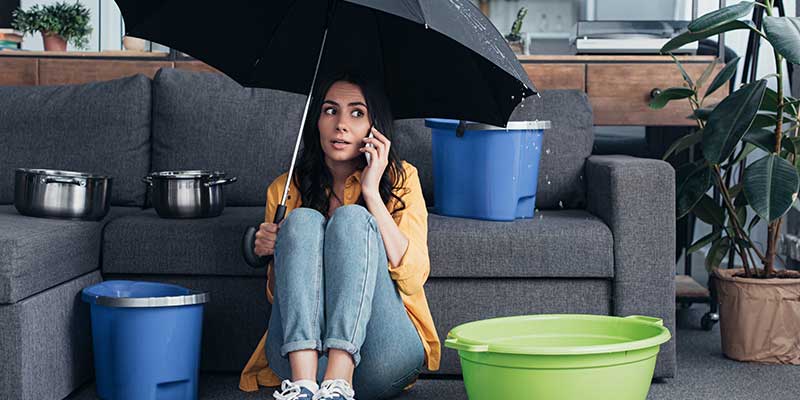4 MIN READ
The Second Most Common Household Damage Claim Is Water Damage
Water damage represents one of the most prevalent kinds of home damage and ranks as the second most common household damage with home insurance claims. Costing billions of dollars annually, water damage impacts at least 1 in 50 homeowners each year. So it’s a great idea to learn about how water damage occurs and what you can do to protect your home.
Common Ways Water Damage Occurs
Water damage in your home can result from a number of household problems, including plumbing leaks, cracks in your basement or foundation, leaking windows, dilapidated siding and ragged roofing. When your home was originally built it was probably more water resistant than it currently is. Over time, your home begins to deteriorate and requires regular maintenance to ensure waterproofing and optimal functioning.
SFW Construction is a professional home repair and home improvement company that specializes in home renovation, weatherproofing, and structural repairs. We can help you prevent water damage and look for signs that water damage is already occurring. We also provide a range of restorative services, including leaking window repair, siding repair, roofing repair, and general carpentry.
Water Damage: A Covert Operation Or All-Out Assault?
Water damage can be a clandestine affair, occurring beneath your floorboards or walls, out of view. Or it can be as obvious as a badly leaking window or roof. With perforations in siding, minor roof leakage, and lack of flashing around your windows, moisture can penetrate the inner walls of your home and gradually disintegrate the structure of your home—all without you knowing about it.
Gradual water damage caused by unnoticed ruptures in your home that compromise its weatherproofing can result in damaged electrical wiring, rotting wood in your walls or window frames, and mold. These problems progress over time until you observe signs of the problem, such as discoloration around window frames, malfunctioning windows, and increases in energy bills.
However, water damage can also occur in an all-out assault, inundating your home rapidly and causing damages immediately. Water damaged furniture can swell and delaminate, and furniture that is painted or stained can leach out and discolor the carpet. Couches or other fabrics can also bleed when damaged by water. And severe humidity in your home will tend to cause unpleasant odors.
When left unattended, water damages to your home will increase. Within days fungi will sprout from cracks in wood surfaces, suffusing the air with a musty odor. Wood floors will become warped and may be ruined beyond repair. Other wood structures can swell and split. The paint on your walls will blister and peel, and wallpaper will become unglued and fall away from the walls.
Within weeks water damage will cause mold on wood surfaces and can cause wood to rot. If the water damage has inundated the structure of your home, it may need to be completely gutted and rebuilt. The environment in a home that is severely damaged by water becomes extremely unhealthy for humans and pets alike, as microbial growths, rotting wood and mold can cause serious respiratory problems.
7 Tips to Protect Your Home from Water Damage
#1: Have your home inspected and weatherproofed by SFW Construction. Ensuring that your siding is in good condition, your roofing is solid and your windows are properly flashed are all part of maintaining your home’s capacity to keep the cold, wet weather out and the interior climate dry and comfortable. SFW Construction provides full-scale weatherproofing and home renovation that can keep you safe and warm!
#2: Prevent water seepage in your basement. After heavy rain you might notice water seeping into the basement or ground level of your home. The waterproof cement basement walls or foundation that protected your home for decades may eventually become compromised. SFW Construction can fix this by professionally sealing your basement and foundation to keep the water out.
#3: Have a backwater valve installed. A sewer backup is a stinky mess that you don’t want to encounter – especially in your house! Having a backwater valve enables you to direct the sewage to go out and not come back in. It’s worth the money!
#4: Make sure all household members know the exact location of the main water shut-off valve and how to use it. If a problem occurs in your plumbing system, you want to be able to shut off the water immediately. A burst pipe can issue water rapidly into your home, and having the capacity to shut it off will save you from a tragic situation.
#5: Maintain indoor plumbing systems by inspecting hoses and faucets. Make sure the hoses leading to all major household appliances are in good condition so that you can avoid unnecessary leaks.
#6: Check and maintain sprinkler and irrigation systems. If left unchecked, a malfunctioning sprinkler or irrigation system can cause water damage to the basement and foundation of your home. Make sure all outside faucets are turned off when not in use.
#7: Ensure the washing machine and dishwasher are off when you leave the house. It might sound far-fetched, but if one of these appliances malfunctions when you aren’t home, you could encounter a flood condition when you return. So it’s best to only use them when you’re going to be home.
Be Proactive with Preventing Water Damage
Providing regular maintenance to your home and knowing the signs of wear and tear that can lead to water damage are the best ways to secure the health of your home and all who live in it. Having a professional home construction and home improvement company inspect your home can help train you to know what to look for.
Contact SFW Construction today for a free consultation on preventing and repairing water damage in your home!


